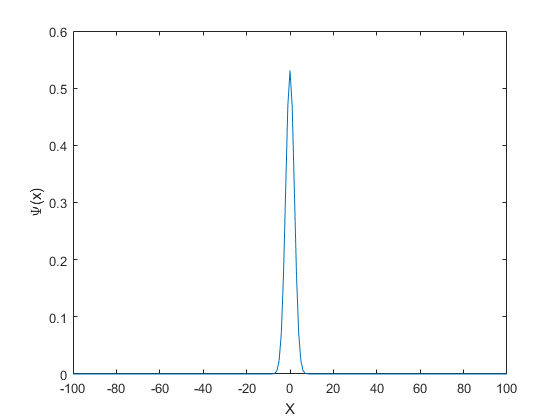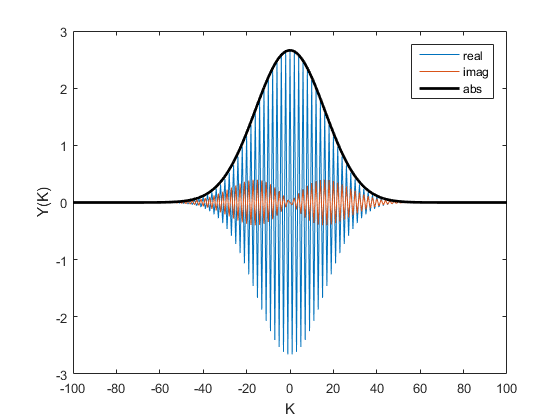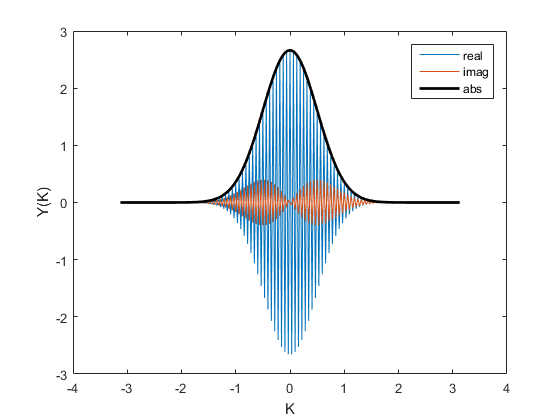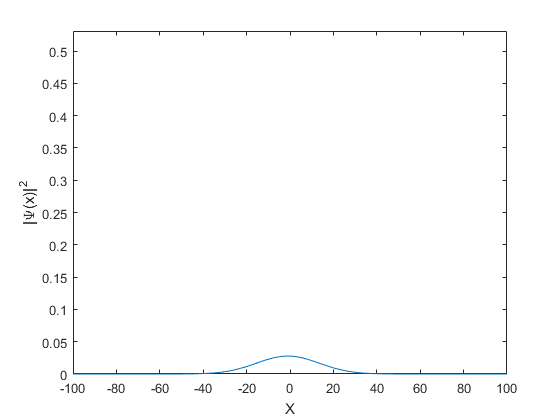Particle Wave Packets
A particle in free space who's momentum is known exactly can be described by the plane wave probability amplitude function:
Contents

where

 and
and

We will consider a particle that is localized in space with a Gaussian probabilty amplitude distribution at t=0 is:

Our appoach is to project this wave packet onto the plane wave solutions, then let each plane wave evolve as $e^{i( k x - \omega t)}%
Lets make a wave packet
Lets take hbar=1, m=1
N=201; X=linspace(-100,100,N); DX=X(2)-X(1); Sigma=2; A=normpdf(X,0,Sigma); A=A/sqrt(A*A'*DX); %Normalize figure plot(X,A) xlabel('X');ylabel('\Psi(x)')

Write wave packet as a sum of plane waves
% Expanding into plane waves is just the Fourier transform: Y=fftshift(fft(A)); K=(0:N-1); K(K>N/2)=K(K>N/2)-N; K=fftshift(K); % Plot the wave in k-space (this is spatial frequency) figure plot(K,real(Y)) hold plot(K,imag(Y)) plot(K,abs(Y),'k','linewidth',2) legend('real','imag','abs') xlabel('K');ylabel('Y(K)') % Note the magnitude of the Y(k) is also a Gaussian. % The FT of a Gaussian is a Gaussian. % web('http://mathworld.wolfram.com/FourierTransformGaussian.html') % Plot as wave number with correct units figure DK=1/(N*DX); KWV=2*pi*K*DK; %Wave number plot(KWV,real(Y)) hold plot(KWV,imag(Y)) plot(KWV,abs(Y),'k','linewidth',2) legend('real','imag','abs') xlabel('K');ylabel('Y(K)')
Current plot held Current plot held


Now let's reconstruct the wave from Fourier coefficients at t=0
close all Wave=0 figure for kk=1:N KS=K(kk); %Spatial frequency KWV=2*pi*KS; %Wave number PlaneWave=1/N*exp(i*KWV*(0:N-1)/N); Wave=Wave+Y(kk)*PlaneWave; plot(X,real(Wave)) xlabel('X');ylabel('\Psi(x)') pause(.01) end
Wave =
0

Now let's look at time evolution
Tvec=linspace(0,.001,100); figure for tt=1:length(Tvec) Wave=0; t=Tvec(tt); for kk=1:N KS=K(kk); %Spatial frequency KWV=2*pi*KS; %Wave number W=1/2*KWV^2; %Omega PlaneWave=Y(kk)/N*exp(i* (KWV/N*(1:N)-W*t) ); Wave=Wave+PlaneWave; end plot(X,abs(Wave).^2) axis([-100 100 0 max(A)]) xlabel('X');ylabel('|\Psi(x)|^2') pause(.01) end
